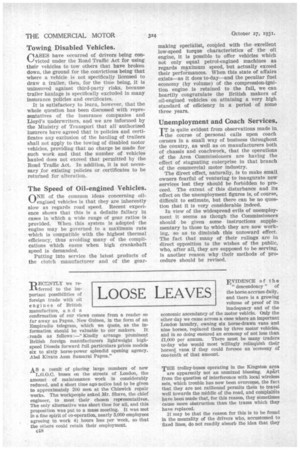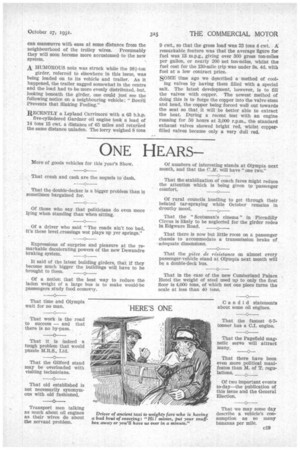LOOSE LEAVES
Page 68

Page 69

If you've noticed an error in this article please click here to report it so we can fix it.
VIO ECENTLY we re-LLferred to the important possibilities of foreign trade with oil engines of British manufacture, and a confirmation of our views comes from a reader so far away as Papua, New Guinea, in the form of an Empiradio telegram, which we quote, as the information should be valuable to our makers. It reads as follows :—" Kindly arrange prominent British foreign manufacturers lightweight highspeed Diesels forward full particulars prices models six to sixty horse-power splendid opening agency. Abel Kivato Assn Samarai Papua."
AS a result of placing large numbers of new L.G.O.C. buses on the streets of London, the amount of maintenance work is considerably reduced, and a short time ago notice had to be given to approximately 200 men at the Chiswick repair works. The workpeople asked Mr. Shave, the chief engineer, to meet their chosen representatives. The only alternative was short time for all, and this proposition was put to a mass meeting. It was met in a fine spirit of co-operation, nearly 3,000 employees agreeing to work 41 hours less per week, so that the others could retain their employment. EVIDENCE of the " descendency " of the horse accrues daily, and there is a growing volume of proof of its inadequacy and of the economic ascendancy of the motor vehicle. Only the other day we came across a case where an important London laundry, owning six horse-drawn vans and nine horses, replaced them by three motor vehicles, and in so doing ensured an economy of not less than 11,000 per annum. There must be many traders to-day who would most willingly relinquish their horsed vans if they could foresee an economy of one-tenth of that amount.
THE trolley-buses operating in the Kingston area are apparently not an unmixed blessing. Apart from the question of interference with local wireless sets, which trouble has now been overcome, the fact that they are not railbound permits them to travel well towards the middle of the road, and complaints have been made that, for this reason, they sometimes cause more obstruction than the trams which they have replaced.
It may be that the reason for this is to be found in the mentality of the drivers who, accustomed to fixed lines, do not readily absorb the idea that they can manceuvre with ease at some distance from the neighbourhood of the trolley wires. Presumably they will soon become more accustomed to the new system.
A HUMOROUS note was struck while the 98i-ton girder, referred to elsewhere in this issue, was being loaded on to its vehicle and trailer. As it happened, the trailer sagged somewhat in the centre and the load had to be more evenly distributed, but, looking beneath the girder, one could just see the following notice on a neighbouring vehicle: "Bovril Prevents that Sinking Feeling."
RECENTLY a Leyland Carritnore with a 63 five-cylindered Gardner oil engine took a load of 14 tons 15 cwt. a distance of 65 miles and returned the same distance unladen. The lorry weighed 8 tons 9 cwt., so that the gross load was 23 tons 4 cwt. A: remarkable feature was that the average figure for fuel was 13 m.p.g., giving over 300 gross ton-miles per gallon, or nearly 200 net ton-miles, whilst the fuel cost for the 130-mile trip was under 3s. 4d. with fuel at a low contract price.
SOME time ago we described a method of cool ing valves by having them filled with a special salt. The latest development, however, is to fill the valves with copper. The newest method of doing this is to forge the copper into the valve stem arid head, the copper being forced well out towards the seat so that it will be better able to extract the heat. During a recent test with an engine running for 50 hours at 3,000 r.p.m., the standard exhaust valves showed bright red, whilst copperfilled valves became only a very dull red.




































































































































































